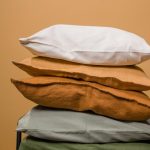When you spend a day hiking under the sun, you want clothing that keeps you comfortable and protected. Fabrics like wool and bamboo not only offer breathability but also shield you from harmful UV rays. But what makes these materials stand out? Understanding their unique properties can help you make better choices for outdoor activities. Let’s explore how these natural fabrics blend protection with comfort.
Table of Contents
Key Takeaways
- Wool provides a natural shield against UV rays while maintaining breathability for outdoor activities.
- Unbleached cotton naturally absorbs UV rays and allows for air circulation, keeping users cool.
- Merino wool combines breathability with UV defense, effectively regulating body temperature.
- Bamboo fabric offers lightweight, breathable UV protection and moisture-wicking properties for active lifestyles.
- Hemp fabric is strong and breathable, providing excellent UV protection while being durable and eco-friendly.
Wool: A Natural Shield Against UV Rays
Wool is more than just a cozy fabric; it’s a natural shield against UV rays. When you wear wool, you’re not only enjoying its warmth but also benefiting from its impressive ability to block harmful UV radiation. This makes it an excellent choice for outdoor activities, whether you’re hiking, camping, or just enjoying a sunny day.
Unlike synthetic fabrics, wool’s natural structure helps it maintain breathability while providing protection. You’ll stay cool in warmer weather, as it wicks moisture away from your skin.
Plus, wool’s durability guarantees that it stands up to various conditions without losing its protective qualities. So, next time you’re heading outdoors, consider choosing wool for both comfort and UV defense.
Unbleached Cotton: Combining Comfort and Protection
When you choose unbleached cotton, you’re opting for a fabric that naturally absorbs UV rays while keeping you comfortable.
Its soft and breathable qualities make it perfect for those sunny days when you want to stay protected without sacrificing comfort.
Natural UV Absorption
Unbleached cotton not only offers a soft, comfortable feel against your skin but also provides natural UV absorption, making it an excellent choice for sun protection.
When you wear unbleached cotton, you’re benefiting from its unique properties that help shield you from harmful rays.
Here are some reasons to choose unbleached cotton for UV protection:
- Natural fibers: The absence of bleaching agents means the fibers retain their inherent protective qualities.
- Breathable: While it blocks UV rays, it still allows air to circulate, keeping you cool.
- Eco-friendly: Unbleached cotton is produced with fewer chemicals, making it a sustainable option.
With these advantages, unbleached cotton not only feels great but helps you stay safe under the sun.
Soft and Breathable
Choosing unbleached cotton means you’re embracing a fabric that expertly combines comfort and protection. This natural fiber feels soft against your skin, making it perfect for warm days. Its breathability guarantees you stay cool, while its UV-resistant properties offer valuable defense against harmful rays.
Unlike bleached cotton, unbleached retains its natural state, preserving essential oils that enhance comfort. You’ll appreciate how it wicks moisture away, keeping you dry and comfortable throughout the day. Plus, it’s gentle on sensitive skin, making it an ideal choice for everyone in the family.
In addition to its practical benefits, unbleached cotton is environmentally friendly, reducing your carbon footprint.
Merino Wool: The Breathable Barrier
Although many fabrics claim to offer comfort and protection, merino wool stands out as a remarkable choice that combines breathability with UV defense.
This natural fiber not only keeps you cool during warm days but also provides a barrier against harmful UV rays.
Here’s why you should consider merino wool for your wardrobe:
- Moisture-wicking: It absorbs sweat away from your skin, keeping you dry and comfortable.
- Temperature regulation: Merino wool adjusts to your body temperature, ensuring you stay cool in heat and warm in cooler conditions.
- Natural UV protection: The fibers provide a shield against the sun’s rays, giving you peace of mind outdoors.
With merino wool, you can enjoy outdoor activities without sacrificing comfort or safety.
Bamboo Fabric: Eco-Friendly UV Defense
When you’re looking for an eco-friendly option that offers both comfort and UV protection, bamboo fabric is an excellent choice.
This sustainable material not only feels soft against your skin but also boasts natural UV-blocking properties. Bamboo fibers are lightweight and breathable, allowing air to circulate and keeping you cool on hot days.
Bamboo fabric offers a soft touch and natural UV protection, keeping you cool and comfortable on warm days.
Plus, it’s moisture-wicking, which helps draw sweat away from your body, ensuring you stay dry and comfortable. The fabric’s antimicrobial qualities also help reduce odors, making it perfect for active lifestyles.
With bamboo fabric, you can enjoy outdoor activities without worrying about harmful UV rays, all while choosing a sustainable option that’s gentle on the planet.
Embrace the benefits of bamboo and elevate your wardrobe today!
Hemp Fabric: Strength and Sun Protection
Bamboo fabric offers a fantastic blend of comfort and UV protection, but if you’re seeking something even more robust, hemp fabric is a powerful alternative.
Known for its strength, hemp provides excellent UV protection while also being breathable, making it perfect for outdoor activities. This natural fabric not only shields your skin but also keeps you comfortable in various temperatures.
Here are three reasons to evaluate hemp fabric:
- Durability: Hemp is incredibly strong and can withstand wear and tear, lasting longer than many other fabrics.
- Moisture-wicking: It effectively absorbs moisture, helping you stay dry and cool.
- Eco-friendly: Hemp grows quickly and requires fewer pesticides, making it a sustainable choice for conscious consumers.
Choose hemp for a blend of strength and sun protection!
The Role of Fabric Structure in Performance
Understanding how fabric structure influences performance is essential for making informed choices in outdoor gear. The way fibers are woven or knitted affects breathability, UV protection, and moisture management. For instance, a loose weave allows better air circulation, keeping you cool during hot weather, while a tighter weave can block harmful UV rays more effectively.
Additionally, the thickness and texture of the fabric play significant roles; thicker materials may provide more insulation but can trap heat, while thinner options enhance breathability.
You’ll also want to take into account fabric treatments that boost UV resistance without sacrificing comfort. Ultimately, understanding these structural elements helps you select fabrics that meet your outdoor needs, ensuring you stay protected and comfortable in varying conditions.
Frequently Asked Questions
Can Synthetic Fabrics Provide Better UV Protection Than Natural Fibers?
Sure, synthetic fabrics can certainly shield you better against harmful UV rays than some natural fibers. Their tight weaves and special treatments enhance protection, making them a smart choice for sun-smart, stylish summer outfits.
How Does Fabric Color Influence UV Protection Effectiveness?
Fabric color can considerably influence UV protection. Darker colors absorb more UV rays, offering better protection, while lighter colors reflect sunlight, potentially allowing more rays to penetrate. Choosing the right color can enhance your sun safety.
Are There Any Treatments to Enhance Natural Fabric UV Resistance?
You’d think treating fabrics for UV resistance would be as simple as a sunblock application, right? Actually, chemical treatments like UV inhibitors or finishes can effectively enhance natural fabric’s UV protection without sacrificing breathability.
Which Natural Fibers Are the Most Durable Against UV Exposure?
When considering durability against UV exposure, you’ll find that fabrics like hemp, linen, and cotton are strong contenders. They maintain their integrity over time while providing some natural protection from harmful sun rays.
What Is the Best Fit for Maximizing UV Protection?
Imagine a superhero cape that shields you from harmful rays! For maximizing UV protection, opt for tightly woven fabrics like polyester or nylon. They block UV rays effectively while still allowing your skin to breathe.
- The History and Evolution of Chamois Fabric - June 22, 2025
- Chamois Fabric on Wikipedia: What You Need to Know - June 22, 2025
- How to Pronounce Chamois Fabric Correctly - June 22, 2025







